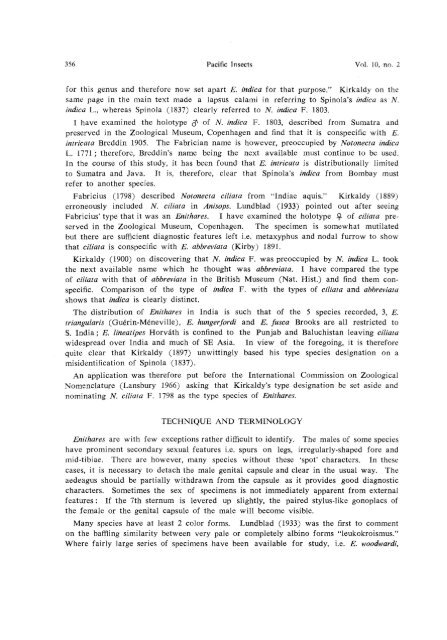THE ENITHARES (Hemiptera-Heteroptera: Notonectidae) OF THE ...
THE ENITHARES (Hemiptera-Heteroptera: Notonectidae) OF THE ...
THE ENITHARES (Hemiptera-Heteroptera: Notonectidae) OF THE ...
You also want an ePaper? Increase the reach of your titles
YUMPU automatically turns print PDFs into web optimized ePapers that Google loves.
356 Pacific Insects Vol. 10, no. 2<br />
for this genus and therefore now set apart E. indica for that purpose." Kirkaldy on the<br />
same page in the main text made a lapsus calami in referring to Spinola's indica as N.<br />
indica L., whereas Spinola (1837) clearly referred to N. indica F. 1803.<br />
I have examined the holotype $ of N. indica F. 1803, described from Sumatra and<br />
preserved in the Zoological Museum, Copenhagen and find that it is conspecific with E.<br />
intricata Breddin 1905. The Fabrician name is however, preoccupied by Notonecta indica<br />
L. 1771 ; therefore, Breddin's name being the next available must continue to be used.<br />
In the course of this study, it has been found that E. intricata is distributionally limited<br />
to Sumatra and Java. It is, therefore, clear that Spinola's indica from Bombay must<br />
refer to another species.<br />
Fabricius (1798) described Notonecta ciliata from "Indiae aquis." Kirkaldy (1889)<br />
erroneously included N. ciliata in Anisops. Lundblad (1933) pointed out after seeing<br />
Fabricius' type that it was an Enithares. I have examined the holotype Sf. of ciliata preserved<br />
in the Zoological Museum, Copenhagen. The specimen is somewhat mutilated<br />
but there are sufficient diagnostic features left i.e. metaxyphus and nodal furrow to show<br />
that ciliata is conspecific with E. abbreviata (Kirby) 1891.<br />
Kirkaldy (1900) on discovering that JV. indica F. was preoccupied by N indica L. took<br />
the next available name which he thought was abbreviata. I have compared the type<br />
of ciliata with that of abbreviata in the British Museum (Nat. Hist.) and find them conspecific.<br />
Comparison of the type of indica F. with the types of ciliata and abbreviata<br />
shows that indica is clearly distinct.<br />
The distribution of Enithares in India is such that of the 5 species recorded, 3, E.<br />
triangularis (Guerin-Meneville), E. hungerfordi and E. fusca Brooks are all restricted to<br />
S. India; E. lineatipes Horvath is confined to the Punjab and Baluchistan leaving ciliata<br />
widespread over India and much of SE Asia. In view of the foregoing, it is therefore<br />
quite clear that Kirkaldy (1897) unwittingly based his type species designation on a<br />
misidentification of Spinola (1837).<br />
An application was therefore put before the International Commission on Zoological<br />
Nomenclature (Lansbury 1966) asking that Kirkaldy's type designation be set aside and<br />
nominating N. ciliata F. 1798 as the type species of Enithares.<br />
TECHNIQUE AND TERMINOLOGY<br />
Enithares are with few exceptions rather difficult to identify. The males of some species<br />
have prominent secondary sexual features i.e. spurs on legs, irregularly-shaped fore and<br />
mid-tibiae. There are however, many species without these 'spot' characters. In these<br />
cases, it is necessary to detach the male genital capsule and clear in the usual way. The<br />
aedeagus should be partially withdrawn from the capsule as it provides good diagnostic<br />
characters. Sometimes the sex of specimens is not immediately apparent from external<br />
features: If the 7th sternum is levered up slightly, the paired stylus-like gonoplacs of<br />
the female or the genital capsule of the male will become visible.<br />
Many species have at least 2 color forms. Lundblad (1933) was the first to comment<br />
on the baffling similarity between very pale or completely albino forms "leukokroismus."<br />
Where fairly large series of specimens have been available for study, i.e. E. woodwardi,

















